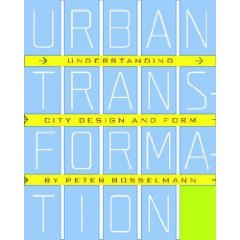February 24, 2009 Categories: Reviews
Urban Transformation: Understanding City Design and Form
2008. Island Press. 310 pp. $90 cloth, $45 paper.
Peter Bosselmann’s new book is more like a series of conversations than a sequence of arguments leading to a definitive conclusion. Bosselman starts with seven activities typical of urban design — comparing, observing, measuring, transforming, defining, modeling, and interpreting. Instead of pontificating on these terms, he simply lets us watch over his shoulder (the many visuals are tightly integrated into the text) while he does each of them. The resulting book is unique, at once informal and rigorous, and unexpectedly charming.

Those with some acquaintance with the literature will take heart when he names among his valued colleagues Christopher Alexander, Allan Jacobs, and Dan Solomon. Many of his sentences keep on thinking as you read them; one imagines they might have grown out of that roundtable — for instance, “Cities are not a form of art, but the process of city design involves the art of creating cities that heighten daily experiences, preferably good experiences, but the bad cannot be ignored.” {xix} After remarks of this kind, the reader can proceed with some confidence that he or she will not simply be indoctrinated.
“To Compare” is by far the longest chapter, and in many ways the most striking. It’s centered on 41 maps of world cities (as of 1995), all drawn to the same scale. Among other things, Bosselmann pulls out three places with populations around 7 million (the San Francisco Bay area, Hong Kong, and the Randstad in the Netherlands) and sets their maps side by side. Those seven million people take up amazingly different amounts of space in these three different places. {6}
Of equal interest is different cities’ different scales — Beijing, where in many places “it seems as if a gigantic rake has plowed through the fabric eradicating narrow lanes and small-scale housing, leaving equally spaced high slabs of buildings” in superblocks. By contrast, even Rome’s monuments “are embedded in a small-scaled texture of a very fine grain. … It is not the age of buildings in Rome that determines the scale. The buildings surrounding the historic monuments of Rome are not old; most date from the nineteenth and twentieth centuries. However, the property configurations and parcel dimensions are much older. The ownership pattern of relatively small parcels has been resilient and continues to define the scale of Rome’s urban fabric to the present day.” {98-9}
Because the book is in part an introduction to the subject, Bosselmann does not assume that the reader knows all the implications of a fine-grained city: ""A person stepping out of the National Archives on 700 Pennsylvania Avenue and walking across Ninth and Tenth avenues will reach the entrance of the Old Post Office in four short minutes and encounter six buildings. On a walk of identical length a person walking at the same pace along Copenhagen’s pedestrian street will encounter in four seemingly much longer minutes forty-two buildings." {99}
This point becomes salient in the later chapter on transformation, because the cardinal sin of urban renewal was not simply that it involved leveling whole neighborhoods, but that it assembled many small parcels into single units, obliterating the area’s past and coarsening the texture of the city. That chapter focuses on Oakland’s history as embedded in its early grids and lot sizes, and how alternative proposals for transforming its shaky present make all the difference as to whether they respect and build on that past. Bosselmann admits to some astonishment that the narrow urban-renewal view of efficiency still holds considerable sway in planning circles even today. {219-20}
In “To Measure,” we get to look over Bosselmann’s students’ shoulders, as they seek out “natural experiments” that allow them to compare otherwise similar streets with different income levels, or different densities, or different traffic levels, and try to measure the slippery and overlapping concepts of vitality, livability, and sense of belonging. The students’ hypotheses often don’t prove out, or the results are confusing — this is the real stuff. One group hypothesized that unique and easily distinguishable street forms would produce a strong sense of place and community, but interviews didn’t show this. In a followup, they compared a street segment where the dwellings were set back a few feet from the street with one where they weren’t. “The team found that on the block with transition zones people knew more neighbors and more by name,” but at the same time residents of both blocks gave similar answer to questions about friendliness and neighbors’ concern for each other. Bosselmann writes, “This suggests that the physical qualities of a space do not necessarily influence perceptions of social behavior, even if they do affect the behavior itself.” {185} We’re a long way from dogmatic intuitive statements about how space and community life relate. Don’t miss this treat of a book.
#
